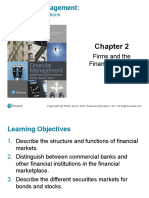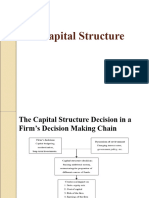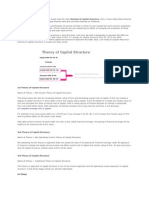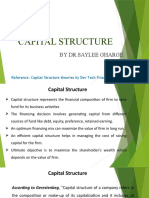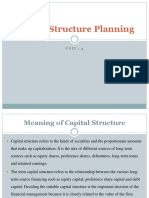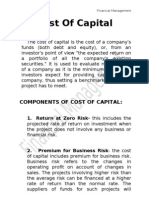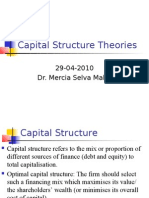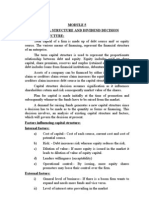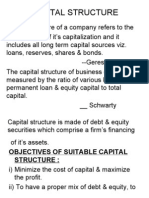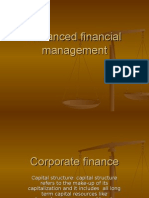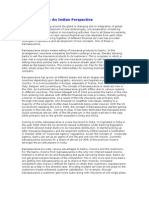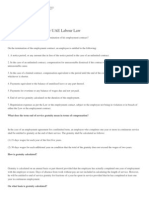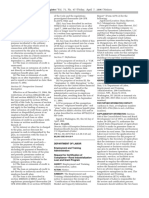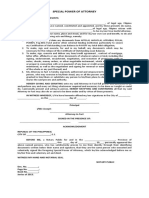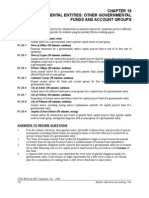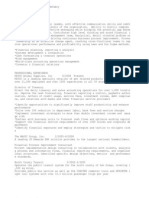Capital Structure: Definition: Capital Structure Is The Mix of Financial Securities Used To Finance The Firm
Capital Structure: Definition: Capital Structure Is The Mix of Financial Securities Used To Finance The Firm
Uploaded by
Arun NairCopyright:
Available Formats
Capital Structure: Definition: Capital Structure Is The Mix of Financial Securities Used To Finance The Firm
Capital Structure: Definition: Capital Structure Is The Mix of Financial Securities Used To Finance The Firm
Uploaded by
Arun NairOriginal Title
Copyright
Available Formats
Share this document
Did you find this document useful?
Is this content inappropriate?
Copyright:
Available Formats
Capital Structure: Definition: Capital Structure Is The Mix of Financial Securities Used To Finance The Firm
Capital Structure: Definition: Capital Structure Is The Mix of Financial Securities Used To Finance The Firm
Uploaded by
Arun NairCopyright:
Available Formats
CAPITAL STRUCTURE
Definition: Capital Structure is the mix of financial securities used to finance the firm. Capital structure is combination of sources of funds in which we can include two main sources' proportion. One is share capital and other is Debt. Capital structure refers to the mix or proportion of different sources of finance (debt and equity) to total capitalization. Optimal capital structure: The firm should select such a financing mix which maximizes its value/the shareholders wealth (or minimizes its overall cost of capital)
Net Income Theory of Capital Structure This theory gives the idea for increasing market value of firm and decreasing overall cost of capital. A firm can choose a degree of capital structure in which debt is more than equity share capital. It will be helpful to increase the market value of firm and decrease the value of overall cost of capital. Debt is cheap source of finance because its interest is deductible from net profit before taxes. After deduction of interest company has to pay less tax and thus, it will decrease the weighted average costofcapital. For example if you have equity debt mix is 50:50 but if you increase it as 20: 80, it will increase the market value of firm and its positive effect on the value of per share. High debt content mixture of equity debt mix ratio is also called financial leverage. Increasing of financial leverage will be helpful to for maximize the firm's value. Capital structure is relevant as it affects the ko(firm s cost of capital) and V(value of the firm) of the firm. Core of the approach: As the ratio of less expensive source of funds increases in the capital structure, ko (firm s cost of capital) decreases and V of the firm increases. With a judicious mix of debt and equity a firm can evolve an optimum capital structure at which ko (firm s cost of capital) would be the lowest and the V of the firm highest and the market price per share the maximum.
Assumptions No corporate tax Cost of debt is less than cost of equity Use of debt does not change the risk perception of investors if the firm is using equity capital alone, the composite cost of capital will be equal to Ke (cost of equity) and the value of the firm will be minimum.
Net Operating Income Theory of Capital Structure Net operating income theory or approach does not accept the idea of increasing the financial leverage under NI approach. It means to change the capital structure does not affect overall cost of capital and market value of firm. At each and every level of capital structure, market value of firm will be same.The market value of the firm is ascertained by capitalizing the net operating income at the composite cost of capital (Ko) which is considered to be constant V= EBIT Ko S= V-B S= Value of equity, V= Total value of firm, B= Total value of debt Net operating Income Approach(NOI) Argument An increase in the proportion of debt in the capital structure would lead to an increase in the financial risk to the equity holders. To compensate for the increased risk, they would require a higher rate of return (ke) on their investment. As a result, the advantage of the lower cost of debt would be neutralized by the increase in the cost of equity. Traditional Theory of Capital Structure This theory or approach of capital structure is mix of net income approach and net operating income approach of capital structure. It has three stages which you should understand: Ist Stage In the first stage which is also initial stage, company should increase debt contents in its equity debt mix for increasing the market value of firm. 2nd Stage In second stage, after increasing debt in equity debt mix, company gets the position of optimum capital structure, where weighted cost of capital is minimum and market value of firm is maximum. So, no need to further increase in debt in capital structure. 3rd Stage Company can gets loss in its market value because increasing the amount of debt in capital structure after its optimum level will definitely increase the cost of debt and overall cost of capital.
Modigliani and Miller MM theory or approach is fully opposite of traditional approach. This approach says that there is not any relationship between capital structure and cost of capital. There will not effect of increasing debt on cost of capital. Value of firm and cost of capital is fully affected from investor's expectations. Investors' expectations may be further affected by large numbers of other factors which have been ignored by traditional theorem of capital structure. They concur with NOI.Provide a behavioral justification for the irrelevance of capital structure. They maintain that the cost of capital and the value of the firm do not change with the change in leverage MM Proposition I The firms market value is not affected by capital structure; any combination of debt and equity is as good as any other Arbitrage Process Arbitrage or switching will take place to enable investors to engage in the personal or homemade leverage as against the corporate leverage to restore equilibrium in the market. Assumptions of MM I Perfect capital markets Characteristics: 1. Investors are free to buy and sell securities 2. Investors can borrow without restrictions at the same terms as firms do 3. Investors behave rationally. Homogeneous risk classes Characteristics: 1. Firms operate in similar business conditions. 2. Firms have similar operating risk. Risk: Operating risk is defined in terms of the Net Operating Income 3. No taxes 4. Full payment: 100 per cent dividend pay out MM Proposition II Borrowing increase shareholder return, but increases financial risk. The increased financial risk via increased cost of equity exactly offsets the increased return; thus leaving the position of shareholders unchanged.
Criticism of MM Hypothesis 1. 2. 3. 4. 5. Lending and borrowing discrepancy. Non-sustainability of personal and corporate leverages. Transaction costs. Institutional restrictions. Existence of corporate tax
ELEMENTS OF CAPITAL STRUCTURE 1. 2. 3. 4. 5. 6. Capital Mix Maturity and Priority Terms and Conditions Currency Financial Innovations Financial market segments.
Capital mix Firms have to decide about the mix of debt and equity capital. Debt capital can be mobilized from a variety of sources. The firms and analysts use debt ratios, debt service coverage ratios, and the fund flow statement to analyze the capital mix.
Maturity and Priority Equity is the most permanent. Among debt CP has shortest maturity and public debt longest. Capitalized debt, Secured debt, etc. are available. Firms try to become risk neutral by matching the maturity of assets and liabilities.
Terms and Conditions Currency: Overseas Borrowings less costlier Conversion cost On debt servicing On risk reduction
Financial Innovations: To circumvent restrictions Hybrid instruments, securitization, etc.
Financial market segments Debt: Public debt or private debt market Debt: Long term or short term Debt: Domestic, International, Euro
FRAMEWORK FOR CAPITAL STRUCTURE (THE FRICT ANALYSIS) 1. 2. 3. 4. 5. 6. 7. 8. 9. 10. 11. 12. 13. 14. 15. Flexibility Risk Income Control Timing Flexibility legibility Within the debt capacity minimum cost, with delay or immediately for profitable projects Risk Excessive use of debt magnifies risk Income Most advantageous to owners Control Minimum risk of loss of control Timing Feasible to implement at current and future conditions of the capital market
CORPORATE GOVERNANCE
The company would manage its affairs with, Diligence Transparency Responsibility Accountability and Would maximize shareholders wealth
Corporate governance refers to the set of systems, principles and processes by which a company is governed. They provide the guidelines as to how the company can be directed or controlled such that it can fulfill its goals and objectives in a manner that adds to the value of the company and is also beneficial for all stakeholders in the long term. The OECD Principles of Corporate Governance states: "Corporate governance involves a set of relationships between a companys management, its board, its shareholders and other stakeholders. Corporate governance also provides the structure through which the objectives of the company are set, and the means of attaining those objectives and monitoring performance are determined."
Five elements to be considered long term strategic goals employees: past, present and future environment/community customers/suppliers compliance (legal/regulatory)
The four Ps of corporate governance are 1. People 3. Process OBJECTIVES The fundamental objective of corporate governance is to enhance shareholders' value and protect the interests of other stakeholders by improving the corporate performance and accountability. Further, its objective is to generate an environment of trust and confidence amongst those having competing and conflicting interests It strengthens investor's confidence by ensuring company's commitment to higher growth and profits. The aim of Good Corporate Governance is to ensure commitment of the board in managing the company in a transparent manner. Theories of corporate governance 1. Agency theory Shareholder-principal-the owner of the company Manager-agent-who controls 2. The stewardship theory Managers are stewards 3. The stakeholder theory Fundamental responsibility of the firm is to maximize the total wealth of all the stake holder 4. The political theory It states that it is the government that decides the allocation of control, rights, responsibility, profit etc. between owners, managers, employees and other stakeholders Corporate governance practice Good corporate governance requires companies to adopt practices and policies which comprise performance accountability, effective 2.Purpose 4.Performance
management control by the board of directors.Companies are needed to at least have the policies and practices in conformity with the requirements stipulated under clause 49 of the listing agreement Board of directors Audit committee Shareholders/investors grievance committee Remuneration committee Management analysis Communication Auditors certificate on corporate governance
Benefits
It has been finding wide acceptance for its relevance and importance to the industry and economy. It contributes not only to the efficiency of a business enterprise, but also, to the growth and progress of a country's economy. It also has a long term reputational effects among key stakeholders, both internally and externally. Good corporate governance procedures also helps maintain the confidence of investors This will ultimately induce more stable sources of financing Good Corporate Governance standards add considerable value to the operational performance of a company. It provides long term sustenance and strengthens stakeholders' relationship Effective governance reduces perceived risks, consequently reduces cost of capital. It enables board of directors to take quick and better decisions which ultimately improves bottom line of the corporate. Adoption of good corporate governance practices provides stability and growth to the enterprise
LIMITATIONS In today's globalized world, unless a corporation embraces and demonstrates ethical conduct, it will not be able to succeed. Failure to implement good governance procedures has a cost in terms of risk. As competition increases, the environment in which firms operate also changes and in such a dynamic environment the systems of corporate governance also need to evolve.
Principles
Rights and equitable treatment of shareholders Interest of other stake holders Role and responsibilities of the board Integrity and ethical behavior Disclosure and transparency On the development of appropriate framework for promoting good corporate governance standards, codes and practices to be followed globally. These are Cadbury Committee Report-The Financial Aspects of Corporate Governance (1992) Green bury Committee Report on Directors' Remuneration (1995)
These recommendations and principles are mainly focused on structure of the company financial and non-financial disclosures compliance with codes of corporate governance competitive remuneration policy shareholders rights and responsibilities Financial reporting and internal controls, etc.
Future Prospects
Reducing the prominence of the issues of governance The corporate governance has come to assume a center stage in the Board room discussions. India has become one of the fastest emerging nations and be able to access to newer and larger markets around the world
As the global environment changing continuously- need of adopting and sustaining good corporate governance to create values The response of the Government and regulators have also been quick to meet the challenges of corporate delinquency
Quality of corporate governance
Quality depends on the following factors: Integrity of the management ability of the Board adequacy of the processes commitment level of individual Board members quality of corporate reporting Participation of stakeholders in the management; etc...
Cost of capital
Minimum rate of return which a company is expected to earn from a proposed project so as to make no reduction in the earning per share to equity shareholders and its market price. In economic terms there are two approaches to define CoC: 1. It is the borrowing rate of the firm, at which it can acquire funds to finance the proposed project 2. It is the lending rate which the firm could have earned if the firm would have invested elsewhere CoC is a combined cost of each type of source by which a firm raises funds. Importance of CoC Capital Budgeting Decisions Designing the Corporate Financial Structure Deciding about the method of financing in lieu with capital market fluctuations Performance of top management Other areas Eg., dividend policy, working capital
Measuring CoC A realistic measure of CoC should have the following qualities of capital expenditure decisions: 1. It must account for the general uncertainty of expected future returns from investment proposals. 2. It must allow for the various degrees of uncertainty of expected future returns associated with different uses of funds. 3. It must allow for the effects of uncertainty associated with an incremental investment and the uncertainty of returns from the entire asset portfolio of the firm. 4. It must account for a variety of financing means available to a firm. 5. It must allow for the differential effects of financing combination on the amount and quality of residual net benefits accruing to shareholders. 6. It must reflect the changes in the capital market. When we say a firm has a cost of capital of, for example, 12%, we are saying: 1. The firm can only have a positive NPV on a project if return exceeds 12% 2. The firm must earn 12% just to compensate investors for the use of their capital in a project 3. The use of capital in a project must earn 12% or more, not that it will necessarily cost 12% to borrow funds for the project Thus cost of capital depends primarily on the USE of funds, not the SOURCE of funds Weighted Average Cost of Capital (overview) A firms overall cost of capital must reflect the required return on the firms assets as a whole If a firm uses both debt and equity financing, the cost of capital must include the cost of each, weighted to proportion of each (debt and equity) in the firms capital structure This is called the Weighted Average Cost of Capital (WACC)
Cost of Equity The Cost of Equity may be derived from the dividend growth model as follows: P = D / RE g Where the price of a security equals its dividend (D) divided by its return on equity (RE) less its rate of growth (g). We can invert the variables to find RE as follows:
RE = D / P + g But this model has drawbacks when considering that some firms concentrate on growth and do not pay dividends at all, or only irregularly. Growth rates may also be hard to estimate. Also this model doesnt adjust for market risk. Therefore many financial managers prefer the security market line/capital asset pricing model (SML or CAPM) for estimating the cost of equity: RE = Rf + E x (RM Rf) or Return on Equity = Risk free rate + (risk factor x risk premium) Advantages of SML: Evaluates risk, applicable to firms that dont pay dividends Disadvantages of SML: Need to estimate both Beta and risk premium (will usually base on past data, not future projections.) Cost of Debt The cost of debt is generally easier to calculate Equals the current interest cost to borrow new funds Current interest rates are determined from the going rate in the financial markets The market adjusts fixed debt interest rates to the going rate through setting debt prices at a discount (current rate > than face rate) or premium (current rate < than face rate)
Weighted Average Cost of Capital (WACC) WACC weights the cost of equity and the cost of debt by the percentage of each used in a firms capital structure WACC=(E/ V) x RE + (D/ V) x RD x (1-TC) (E/V)= Equity % of total value (D/V)=Debt % of total value (1-Tc)=After-tax % or reciprocal of corp tax rate Tc. The after-tax rate must be considered because interest on corporate debt is deductible
You might also like
- Memorandum of AgreementDocument4 pagesMemorandum of AgreementAldrinmarkquintana80% (10)
- Vantiv Worldpay Confidential Information Memorandum Sep 7Document49 pagesVantiv Worldpay Confidential Information Memorandum Sep 7AlexNo ratings yet
- Capital Structure and LeverageDocument31 pagesCapital Structure and Leveragealokshri25No ratings yet
- Financial Management:: Firms and The Financial MarketDocument54 pagesFinancial Management:: Firms and The Financial Marketsiti aubreyNo ratings yet
- FM S5 Capitalstructure TheoriesDocument36 pagesFM S5 Capitalstructure TheoriesSunny RajoraNo ratings yet
- FM Sheet 4 (JUHI RAJWANI)Document8 pagesFM Sheet 4 (JUHI RAJWANI)Mukesh SinghNo ratings yet
- Financial Management: 1st Theory of Capital StructureDocument7 pagesFinancial Management: 1st Theory of Capital StructureYash AgarwalNo ratings yet
- 1Document5 pages1Pradip AwariNo ratings yet
- Capital StructureDocument55 pagesCapital Structurekartik avhadNo ratings yet
- FM Capital Structure TheoryDocument6 pagesFM Capital Structure Theoryjabeenbegum916No ratings yet
- FM Unit 2Document24 pagesFM Unit 2KarishmaNo ratings yet
- FinanceDocument6 pagesFinanceshrestharupesh808No ratings yet
- Capital StructureDocument4 pagesCapital StructureAdeem Ashrafi100% (2)
- Capital Structure DecisionDocument10 pagesCapital Structure DecisionMunni FoyshalNo ratings yet
- Capital Structure TheoryDocument10 pagesCapital Structure TheoryMd. Nazmul Kabir100% (1)
- Chapter 2 - CompleteDocument29 pagesChapter 2 - Completemohsin razaNo ratings yet
- What Does Capital Structure Mean?Document4 pagesWhat Does Capital Structure Mean?anaqshabbirNo ratings yet
- Capital StructureDocument23 pagesCapital StructureDrishti BhushanNo ratings yet
- Capital Structure Planning: Unit: 3Document46 pagesCapital Structure Planning: Unit: 3Shaifali ChauhanNo ratings yet
- Capital Structure and Firm ValueDocument39 pagesCapital Structure and Firm ValueIndrajeet KoleNo ratings yet
- BBACO302 FMRA ModuleDocument33 pagesBBACO302 FMRA Modulepriyanka.barman.10.aNo ratings yet
- Cost of CapitalDocument16 pagesCost of CapitalBabar AdeebNo ratings yet
- CH 5Document10 pagesCH 5malo baNo ratings yet
- Capital Structure Decision Is Important For A Firm BecauseDocument9 pagesCapital Structure Decision Is Important For A Firm BecauseAditya RathiNo ratings yet
- Mba NotesDocument12 pagesMba NotesSrishtiNo ratings yet
- Capital Structure Theory and PolicyDocument11 pagesCapital Structure Theory and PolicypreetiNo ratings yet
- Capital Structure: Meaning of Capital Structure Theories of Capital StructureDocument21 pagesCapital Structure: Meaning of Capital Structure Theories of Capital Structureashanil07No ratings yet
- Corp Finance Group One Course Work (Final)Document27 pagesCorp Finance Group One Course Work (Final)jonas sserumagaNo ratings yet
- Cost of CapitalDocument13 pagesCost of CapitalManvendra ShahiNo ratings yet
- Our ProjectDocument7 pagesOur ProjectYoussef samirNo ratings yet
- Unit 3rd Financial Management BBA 4thDocument18 pagesUnit 3rd Financial Management BBA 4thYashfeen FalakNo ratings yet
- Mba Corporate FinanceDocument13 pagesMba Corporate FinanceAbhishek chandegraNo ratings yet
- FM THEORYDocument17 pagesFM THEORYaryank281103No ratings yet
- Capital Structure TheoriesDocument26 pagesCapital Structure Theoriesprajii100% (1)
- Cap Stru and Div DeciDocument19 pagesCap Stru and Div DecimuddiniNo ratings yet
- Financial ManagementDocument8 pagesFinancial Managementpankaj91834No ratings yet
- Notes of Corporate Finance: BBA 8th SemesterDocument10 pagesNotes of Corporate Finance: BBA 8th SemesterÀmc ChaudharyNo ratings yet
- InvestopidiaDocument18 pagesInvestopidiatinasoni11No ratings yet
- Unit Iv: Financing DecisionsDocument11 pagesUnit Iv: Financing DecisionsAR Ananth Rohith BhatNo ratings yet
- Capital StructureDocument28 pagesCapital Structureluvnica6348No ratings yet
- Advance Financial ManagementDocument62 pagesAdvance Financial ManagementKaneNo ratings yet
- Corporate Finance: Capital Structure in ISPAT IndustriesDocument28 pagesCorporate Finance: Capital Structure in ISPAT IndustriesGautam KhantwalNo ratings yet
- Hypothetical Capital Structure and Cost of Capital of Mahindra Finance Services LTDDocument25 pagesHypothetical Capital Structure and Cost of Capital of Mahindra Finance Services LTDlovels_agrawal6313No ratings yet
- Chapter 18 - ShanaDocument8 pagesChapter 18 - ShanaHanz SadiaNo ratings yet
- Financial ManagementDocument25 pagesFinancial ManagementNespinNo ratings yet
- Chaitanya Chemicals - Capital Structure - 2018Document82 pagesChaitanya Chemicals - Capital Structure - 2018maheshfbNo ratings yet
- CF Assignment - Capital Structure - FreshDocument3 pagesCF Assignment - Capital Structure - Freshganesh gowthamNo ratings yet
- Capital StructureDocument4 pagesCapital Structureharish chandraNo ratings yet
- Capitasl Expenditure (Final Project)Document42 pagesCapitasl Expenditure (Final Project)nikhil_jbp100% (1)
- Capital Structure: Meaning and Theories Presented by Namrata Deb 1 PGDBMDocument20 pagesCapital Structure: Meaning and Theories Presented by Namrata Deb 1 PGDBMDhiraj SharmaNo ratings yet
- Study MaterialDocument17 pagesStudy MaterialRohit KumarNo ratings yet
- Corporate Finance - Unit 3 NotesDocument6 pagesCorporate Finance - Unit 3 Notesfatimafirdaus147No ratings yet
- University of Central Punjab: F 2020 Course Title: Financial Strategy Course Code: IVA5833Document8 pagesUniversity of Central Punjab: F 2020 Course Title: Financial Strategy Course Code: IVA5833Ayesha HamidNo ratings yet
- Advanced Financial ManagementDocument23 pagesAdvanced Financial ManagementDhaval Lagwankar75% (4)
- LONG QUESTIONSDocument12 pagesLONG QUESTIONSnancymcdonie1204No ratings yet
- A Study On Capital Structure in Sri Pathi Paper and Boards Pvt. LTD., SivakasiDocument69 pagesA Study On Capital Structure in Sri Pathi Paper and Boards Pvt. LTD., SivakasiGold Gold50% (4)
- FM Capital StructureDocument5 pagesFM Capital Structuremugojulius671No ratings yet
- Capital Structure: Compiled To Fulfill The Duties of Financial Management Courses Lecturer: Prof. Dr. Isti Fadah, M.SiDocument10 pagesCapital Structure: Compiled To Fulfill The Duties of Financial Management Courses Lecturer: Prof. Dr. Isti Fadah, M.SiGaluh DewandaruNo ratings yet
- Financial Mmanagement II -Chapter 1Document49 pagesFinancial Mmanagement II -Chapter 1zelalemabirhamNo ratings yet
- Analytical Corporate Valuation: Fundamental Analysis, Asset Pricing, and Company ValuationFrom EverandAnalytical Corporate Valuation: Fundamental Analysis, Asset Pricing, and Company ValuationNo ratings yet
- Textbook of Urgent Care Management: Chapter 46, Urgent Care Center FinancingFrom EverandTextbook of Urgent Care Management: Chapter 46, Urgent Care Center FinancingNo ratings yet
- Mutual FundDocument20 pagesMutual FundArun Nair100% (1)
- Bancassurance: An Indian PerspectiveDocument17 pagesBancassurance: An Indian Perspectivealmeidabrijet100% (1)
- Cash ManageentDocument6 pagesCash ManageentArun NairNo ratings yet
- Management of Sick IndustriesDocument15 pagesManagement of Sick IndustriesArun NairNo ratings yet
- Financial Accounting Mock Test PaperDocument7 pagesFinancial Accounting Mock Test PaperBharathFrnzbookNo ratings yet
- Payment of Gratuity As Per UAE Labour Law: Konkan TimesDocument4 pagesPayment of Gratuity As Per UAE Labour Law: Konkan TimesAdarsh SvNo ratings yet
- Notice: Grants and Cooperative Agreements Availability, Etc.: Rural Industrialization Loan and Grant Program Compliance Certification RequestsDocument2 pagesNotice: Grants and Cooperative Agreements Availability, Etc.: Rural Industrialization Loan and Grant Program Compliance Certification RequestsJustia.comNo ratings yet
- Spa Psslai and AfpslaiDocument1 pageSpa Psslai and Afpslaijci028No ratings yet
- Audit ChecklistDocument46 pagesAudit ChecklistCA Gourav Jashnani67% (3)
- Chapter 18, Modern Advanced Accounting-Review Q & ExrDocument23 pagesChapter 18, Modern Advanced Accounting-Review Q & Exrrlg4814100% (3)
- General Questions: View AnswerDocument4 pagesGeneral Questions: View AnswerVINAY MISHRANo ratings yet
- Agency PaperDocument13 pagesAgency Paperapi-272668024No ratings yet
- Annuities Practice Problem Set 2: Future Value of An AnnuityDocument2 pagesAnnuities Practice Problem Set 2: Future Value of An AnnuityJeric Marasigan EnriquezNo ratings yet
- CFO or Treasurer or Project Manager or ConsultantDocument3 pagesCFO or Treasurer or Project Manager or Consultantapi-121384723No ratings yet
- Keynote SpeechDocument21 pagesKeynote SpeechADBI EventsNo ratings yet
- RPMS AHGElumbaringDocument4 pagesRPMS AHGElumbaringHomil Homil HomilNo ratings yet
- Word Formation Prov VDocument4 pagesWord Formation Prov VAnonymous BF9P5gWINo ratings yet
- Acco 420 Final Coursepack CoursepacAplusDocument51 pagesAcco 420 Final Coursepack CoursepacAplusApril MayNo ratings yet
- Chapter 13 - Weighing Net Present Value and Other Capital Budgeting Criteria QuestionsDocument21 pagesChapter 13 - Weighing Net Present Value and Other Capital Budgeting Criteria QuestionsAhmad RahhalNo ratings yet
- ISAS Working Paper: Capital Account Convertibility in India: Revisiting The DebateDocument27 pagesISAS Working Paper: Capital Account Convertibility in India: Revisiting The DebateHitesh DiyoraNo ratings yet
- Medel vs. CA (299 Scra 481)Document6 pagesMedel vs. CA (299 Scra 481)mgbautistallaNo ratings yet
- Metropolitan Fabrics v. Prosperity Credit DIGEST Art 1391Document2 pagesMetropolitan Fabrics v. Prosperity Credit DIGEST Art 1391kooch100% (1)
- Report of Mrunali S. LilhareDocument2 pagesReport of Mrunali S. LilhareShashank KUmar Rai BhadurNo ratings yet
- Photo Developing and Printing DigitalDocument28 pagesPhoto Developing and Printing DigitalKashif SaeedNo ratings yet
- A Study On Factors Influencing of Women Policyholder's Investment Decision Towards Life Insurance Corporation of India Policies in ChennaiDocument6 pagesA Study On Factors Influencing of Women Policyholder's Investment Decision Towards Life Insurance Corporation of India Policies in ChennaiarcherselevatorsNo ratings yet
- MT China Great Wall of Debt PDFDocument34 pagesMT China Great Wall of Debt PDFBhairavi UvachaNo ratings yet
- 8 Lagrimas V CaDocument4 pages8 Lagrimas V CaMary Joy GorospeNo ratings yet
- Savant BrochureDocument2 pagesSavant BrochurebamapcomNo ratings yet
- 7 Principal Instrument of TransferDocument8 pages7 Principal Instrument of TransferAudrey Vivian50% (2)
- Venu 42 ReportDocument64 pagesVenu 42 ReportSubbaRaoNo ratings yet
- 19th Annual ReportDocument84 pages19th Annual ReportLochan KhanalNo ratings yet



